
It’s been nearly a year since the first wave of “motion capture” enabled dslrs which I have been referring to hslrs or hdcds were announced. So after my eight months of using the Nikon D90 and the Canon 5D MarkII, I decided to revisit the concept of stills and motion.
Needless to say the reaction to the convergence of still and motion capture was mixed and depending on whom you talk to or which Internet forum you read, remains mixed. Some hardcore photographers expressed the sentiment that motion capture in a still camera is a gimmick. Some videographers pointed out limitations that make hslrs suboptimal for capturing motion. Some people adopted a wait and see attitude; yet others have embraced the possibilities with enthusiasm. There are also those who were or are indifferent, as motion capture may be one more feature among many they will not use. The discussions on the convergence of stills and motion reminds me of the discussions several years back when Olympus first “lifted the mirror” facilitating live-view in a dslr or when the monotone capture option which was a feature on point-and-shoots, made its way to dslrs; or even further back to some of the passionate debate on digital capture versus. film. There appears to be a direct correlation between time and acceptance or in some cases perhaps resignation.
Prior to the inclusion of motion capture in dslrs, photographers depended on the high frame-rate per second capability of their cameras to chronicle action. This eliminated many cameras from consideration for action shooters. The inclusion of motion capabilities in still cameras opens up new possibilities for action shooters, and may make cameras, that otherwise would have not been considered for action shooting, contenders.
One thing is for certain: Whether you are talking about the hslrs from Canon and Nikon, hdcds like the Panasonic Lumix GH1 or the Red DMSCs, a convergence of dual capture in a single package is not just coming, it is here. I don’t really understand why the discussion for some comes down to one or the other. Point-and-shoot cameras have had this capability for years and I don’t remember this ever being discussed in the same manner. But then they were not capable of producing the quality of video we are seeing in the current crop of motion capable still cameras.
My own stills/motion “ah ha” moment, came not because I woke up and realized there were three monitors on my desk, or because I found myself rotflmao courtesy of a YouTube video or watching a product promo on a manufacturer’s web-site, but rather while walking between locations in Central Park last August during a wedding shoot. I wasn’t thinking about recording a blockbuster, only capturing a few moments of motion that were visually arresting. I thought my clients would have appreciated such footage, and would have wanted to share it with their friends and family as they had been doing with their still images on Flickr for quite some time. The great irony here is that I usually do not shoot weddings. That was about a week before the Nikon D90 announcement was made. My only experience with motion capture up to that point had been relegated to my cell phone camera.
Since the arrival of the Nikon D90 and the Canon 5D MarkII, video camera accessory makers from Zacuto and Redrock Micro to independent image makers like Bruce Dorn have developed products to enhance the “still to motion” capture experience. There are a growing number of products targeting hslr users with items ranging from focus follow and sliders, to mounting rigs and screen enhancers, some reasonably priced and some extremely expensive. The effort to produce accessories at every price point suggests that still and video convergence is a growing segment of the imaging industry and that there will be a demand for tools to exploit the combined capability by amateurs, enthusiasts, and working image makers. The fact that many products have lengthy waiting lists or are back-ordered, suggests that the manufacturers simply cannot keep up with demand. Perhaps, those embracing motion are not as vocal on Internet forums as those who do not. And perhaps the term “silent majority” is being re-defined.
The number of camera model specific sites which provide information on motion capture or celebrate the capability is growing and is both surprising and impressive. Additionally, there are plenty of people posting samples and instructions on-line of their DYI accessories for motion capture. You might argue about whether a still camera with motion can be used to record a box office hit, but clearly they are very capable for many of the Web-based multimedia and monitor/television-viewed applications that are growing in popularity and becoming a more important part of the entertainment and knowledge acquisition processes.
The area that there has been surprisingly slow to respond to the convergence of motion and stills is lighting, and this remains one of the biggest areas of concern and challenge for photographers. While the camera makers continue to provide either built in and/or supplemental flash solutions, none market a continuous lighting option as part of the available accessories. Additionally some of the more popular names in flash photography continue to release new studio and location powered flash units, but have been silent with respect to continuous lighting products. Between small flashes, small video light solutions, studio flashes and larger continuous lighting sources, the prospects of having four different brands and solutions is mind-numbing, and potentially expensive.
Perhaps no individual early on had a greater impact on getting dslr users to consider the potential of motion capabilities than Vincent Laforet. Laforet’s self-produced and self-financed short “Reverie” which was shot with a Canon 5d MarkII and has become the centerpiece of the camera’s print marketing campaign, generated a tremendous amount of interest and activity. In less than four weeks after Canon announced the camera and nearly two months before the camera hit the stores, Laforet and his blog became a “real-time experience” resource for many. Over a 10 day period, between late September and early October 2008, “Reverie” was reported to have been viewed over 1.5 million times.
With recent firmware changes which have given users greater manual control over the 5D MarkII, along with stir caused by “Reverie,” I cannot help but wonder if Canon was even remotely aware of the possibilities that people would see for the motion enabled dslr beyond the “quick grab.” I am sure this has caught the attention of the other camera manufacturers as well. It is just a matter of time before HD motion capture becomes as common as auto focus in every dslr.
One of the arguments that I hear often with respect to still vs. motion capture is that they are such different disciplines. But in the stills arena, I could make the case that shooting weddings and shooting landscapes are different disciplines; or in the motion arena that shooting shorts and shooting full length features are also different disciplines. There are some substantial differences in stills and motion work, and I don’t want to minimize them – sound, lighting and processing are three of the more obvious ones. But in purely visual terms, I think that the response to how different they are, may be “it depends.” It really does depend on one’s frame of reference. A photographer who is used to shooting against gray paper or muslin backdrops with posed subjects, may find the transition from stills to motion a different experience from a photographer who works from story boards, on sets or in rooms and locations, where the environment is key and the lighting considerations and needs are different; and/or from the photographer who actively directs his or her subjects; or the photo-journalist. It should be noted that photographers have been moving between stills and motion for quite some time. Three photographers who come immediately to mind who made the transition are Stanley Kubrick, Gordon Parks and Herb Ritt.
I asked New York based photographer Mike Kobal, who has embraced the motion capabilities of the first generation of hslrs/hdcds in a big way, to describe the differences he finds between capturing stills and motion. Mike says that “Shooting stills is a subtractive process: I choose the moment to press the button and hopefully capture the essence of what I want to say and what I saw; whereas shooting video is more of an additive process, anticipating the flow of things and editing to complete the story.” Mike has been shooting with the Nikon d90 and Canon 5DMarkII, and recently began working with the Panasonic Lumix GH1.
While some photographers may continue to debate still vs. motion or motion vs. still and often with great passion, there are three things that are not debatable:
- We live in a multi-media age
- The Web continues to evolve and grow; and
- There is a there is a demand for content.
The people who are looking for content don’t care what camera is used: They just want to see the end product. You do not need a $50,000 camera or for that matter even a $1,000 camera to shoot content. But hopefully better tools will lead to better visual quality.
Without getting emotional, let’s look at a few facts related to the U.S.A:
- In April 2009, nearly 79% of the total U.S. Internet audience viewed online video.
- The average online video viewer watched nearly 6.4 hours of video.
- Over 107 million viewers watched 6.8 billion videos on YouTube.com which equates to almost 64 videos per viewer.
- 49 million viewers watched 387 million videos on MySpace.com which equates to nearly 8 videos per viewer.
- The duration of the average online video was 3.5 minutes.
Source: comScore Inc.
The growth in the video trend is not just an American phenomenon:
- The total number of videos viewed online in the U.K. in April 2009 grew to 4.7 billion videos, a 47%increase over the same period in 2008.
- Google sites were the most popular U.K. online video property in April 2009. 2.4 billion Videos were viewed, which represents a 58% increase over the same period in 2008.
- YouTube accounted for 99% of all videos viewed on the Google sites.
Source: comScore Inc.
Sites such as Flickr (Yahoo), SmugMug, and Photobucket (Fox Interactive Media) that were built around the business of photo sharing offer video sharing options to their members: Stills and motion, side by side. Now at this point at least one reader is thinking that a lot of those 5 billion or so videos that were watched are mediocre; but then so are a lot of television shows and movies, not to mention many of the still images that end up on stock sites or are posted on the Web. But there are also plenty of gems out there. It is up to the viewers to choose the wheat or the chaff.
How we image makers define ourselves may have a lot to do with whether and how we embrace the convergence of stills and motion or motion and stills. Even though technology has marched on, we may be saddled with legacy baggage from the film days. Call yourself a photographer and you may be confining yourself to one camp; call yourself a videographer and you may be confining yourself to a different camp. Consider yourself something else like an image maker, or a “stil-mo-tographer,” be open to trying and doing new things, and you may just find that it frees you from the perceived constraints of one discipline versus the other, gives you an advantage and/or opens up new avenues or perhaps keeps you competitive.
I just realized something: As a child the one thing I never did was go to camp.
Glossary:
Hslrs – hybrid single lens reflex cameras
Hdcds – hybrid digital capture devices
DMSC – digital motion and still camera – the Red designation
Rotflmao – you can Google this one!
Note: The hyperlinks that appear throughout this article and site have been included with the consent of the respective product and site owners. Their company names and their respective products names are in many cases registered trademarks /service marks and are the property of the company. I thank them for allowing us to link to their content. This site has no affiliation with any product manufacturer or retailer and its owner receives no consideration, financial or otherwise, from any company or retailer. The entries and images on this site are copyrighted and should not be reproduced with out permission.
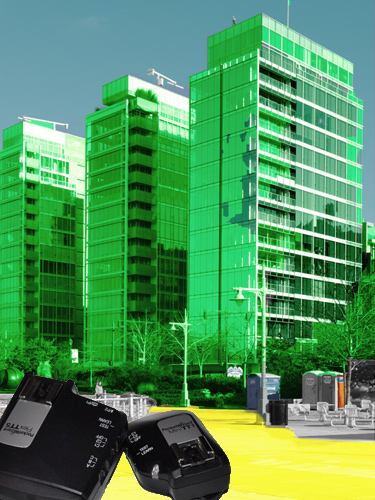
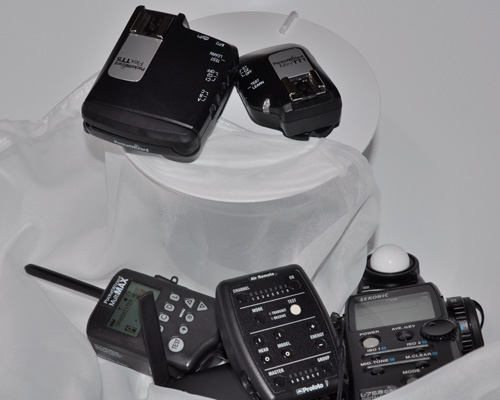 I have been intending to write about the new PocketWizard products for the past several weeks, but every time I’ve scheduled an outdoor shoot, we’ve been rained out. Hopefully the weather will cooperate this weekend and I will be able to finally shoot the project that has been thrice postponed and put the MiniTT1 and FlexTT5s through their paces as I normally would use them and share my experience. I’ll warn you now since I will be shooting on the streets of New York, that I won’t be going for distance records with respect to flash placement.
I have been intending to write about the new PocketWizard products for the past several weeks, but every time I’ve scheduled an outdoor shoot, we’ve been rained out. Hopefully the weather will cooperate this weekend and I will be able to finally shoot the project that has been thrice postponed and put the MiniTT1 and FlexTT5s through their paces as I normally would use them and share my experience. I’ll warn you now since I will be shooting on the streets of New York, that I won’t be going for distance records with respect to flash placement.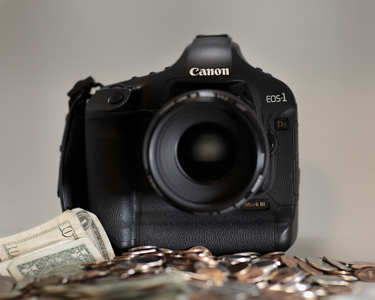 With the availability of full frame dslrs from Canon, Nikon and Sony, there has been a lot of discussion, both on Internet forum boards and in print about camera pricing and in particular, the pricing of “professional” dslrs. John Rettie in an article called
With the availability of full frame dslrs from Canon, Nikon and Sony, there has been a lot of discussion, both on Internet forum boards and in print about camera pricing and in particular, the pricing of “professional” dslrs. John Rettie in an article called 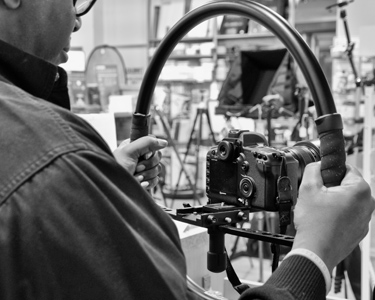 What do you get when you mount a camera inside a steering wheel? You get a Fig Rig!! I keep hearing the Joni Mitchell song “Big Yellow Taxi” every time I think about the Fig Rig! People may find the concept of walking around holding a “steering wheel” in front of you, strange but I have to tell you it works. The Fig Rig offers incredible freedom of movement. The two handed navigation if you will, results in tremendous stability and smooth shooting. The body acts as the shock absorber and does not transfer the jarring movement to the Fig Rig. The wheel itself can accommodate add on’s such as video lights or a microphone using the optional Fig Rig clamp.
What do you get when you mount a camera inside a steering wheel? You get a Fig Rig!! I keep hearing the Joni Mitchell song “Big Yellow Taxi” every time I think about the Fig Rig! People may find the concept of walking around holding a “steering wheel” in front of you, strange but I have to tell you it works. The Fig Rig offers incredible freedom of movement. The two handed navigation if you will, results in tremendous stability and smooth shooting. The body acts as the shock absorber and does not transfer the jarring movement to the Fig Rig. The wheel itself can accommodate add on’s such as video lights or a microphone using the optional Fig Rig clamp.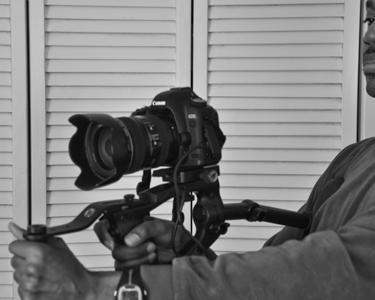
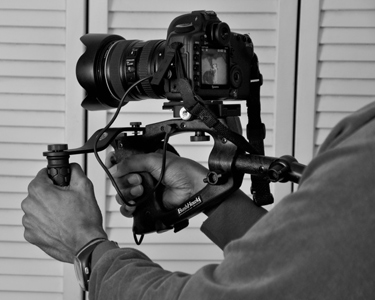
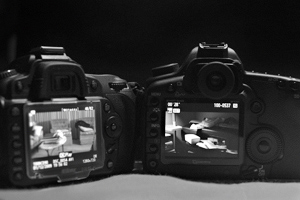


You must be logged in to post a comment.